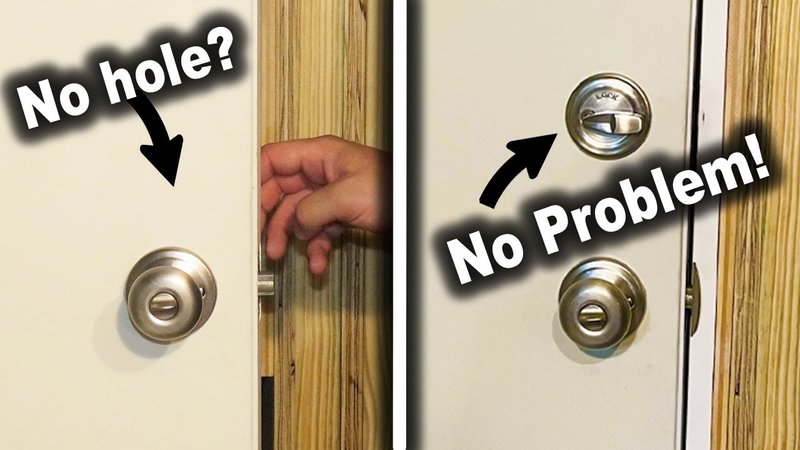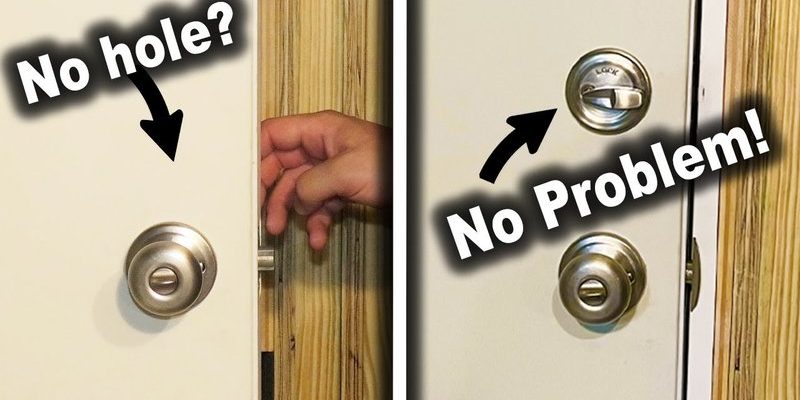
Whether you’ve got a Schlage, Kwikset, or another popular deadbolt brand, the steps are pretty similar. Most deadbolts use a standard setup, so you don’t need any secret codes or technical troubleshooting skills—just a little patience and some basic tools. If you’re worried it’s a huge job, don’t be. With some simple guidance, you’ll have your lock snug and secure again, and you won’t have to call a locksmith.
Why Deadbolts Get Loose In The First Place
Before you start grabbing tools, let’s talk about what’s actually going on. Deadbolts sit inside a hole (the “bore hole”) that’s drilled through your door. Over time, this fit can loosen up for a few reasons. Sometimes, it’s just daily wear and tear: people slamming doors, temperature changes making wood contract or swell, or even the screws working themselves out with every twist of the key.
Honestly, most homeowners run into this problem eventually. If your deadbolt’s loose, you might notice the cylinder spinning a little when you turn the key—or, in worse cases, the whole thing wiggling whenever you touch it. The most common causes include:
- Loose mounting screws inside the lock assembly
- A bore hole that’s gotten too wide, often because the wood has worn down or chipped away
- A metal or plastic sleeve (collar) inside the bore hole that’s missing or damaged
You might be wondering—does a loose deadbolt mean my lock is broken? Not necessarily. Usually, it just means the connection between your deadbolt and the door needs a little TLC.
Tools and Materials You’ll Need
Let me explain this part simply: you don’t need a massive toolkit or specialized supplies. Most fixes only require a handful of items you probably have around the house—or can grab at any hardware store. Here’s what you’ll want on hand before you start:
- Phillips-head screwdriver (or flathead, depending on your lock’s screws)
- Wood filler or toothpicks (if the screw holes are stripped)
- Wood glue (helps secure fillers)
- Drill and bits (for more serious repairs)
- Masking tape (to avoid scratches)
- Replacement screws (sometimes a longer screw is all it takes)
- Chisel or utility knife (if you need to square up a damaged bore hole)
- Measuring tape (to check bore hole diameter)
If you’re dealing with a specific brand like Schlage or Kwikset, the same basics usually apply, but always check the brand’s instructions in case of tricky features.
Step-by-Step: How to Tighten a Loose Deadbolt in the Bore Hole
Here’s the thing—fixing a loose deadbolt is really about giving that lock a sturdy home again. We’re not talking about re-programming a smart lock code or running advanced troubleshooting; it’s good old-fashioned hands-on work.
1. Remove the Deadbolt Assembly
Tape around the lock with masking tape to protect your door’s finish. Open the door, then unscrew the two screws on the inside faceplate of the deadbolt. Slide both sides of the lock and the bolt out of the door, keeping track of any small parts.
2. Inspect the Bore Hole and Lock Components
Look into the bore hole. Is the wood chipped, splintered, or gouged out? If the hole is just a little loose, you might only need to reinforce the screw holes. If the whole opening is worn or oversized, you’ll need to shore it up.
3. Tighten or Replace Screws
If the mounting screws are stripped or loose, you might be able to solve the problem by:
- Filling the screw holes with toothpicks and wood glue, then re-driving the screws
- Using longer screws to bite into fresh wood deeper in the door
Let any glue dry completely before reassembly.
4. Repair or Reinforce the Bore Hole
If the whole bore hole is too big, fill gaps around the lock’s collar with wood filler or a pre-made lock repair kit. Let the filler harden, then carefully re-fit the deadbolt.
5. Reinstall and Test
Pop the deadbolt back in, making sure everything fits tight. Re-install the screws, tightening them firmly (but don’t over-torque, or you’ll strip them again). Test the lock with the door open and closed to make sure it doesn’t wiggle.
You might be surprised how often a “loose” deadbolt just needs a longer screw or a little extra wood filler. It’s not fancy, but it works!
When Should You Replace Parts or the Whole Deadbolt?
Sometimes, a quick repair just isn’t enough—especially if you notice that your deadbolt itself is damaged, warped, or missing key pieces. If the metal cylinder or tailpiece is bent, you’ll probably need a new lock. The same goes if the hole has gotten so wide that even wood filler can’t hold the deadbolt tightly.
With brands like Kwikset and Schlage, you can often get replacement parts (like new collars, screws, or even a bore hole adapter) without buying a whole new lock. But if your lock is old, rusted, or just plain stubborn, replacing the whole unit might be the simplest fix.
Here’s how to know it’s time to shop for something new:
- Parts are missing or broken beyond repair
- Lock still wobbles after you’ve tightened and reinforced everything
- Your deadbolt doesn’t line up with the strike plate, even after adjustments
Sometimes, a universal deadbolt fits better in an older door, especially if you can’t find your exact brand’s replacement part. Just make sure the new lock matches your bore hole size (usually 2 1/8 inches for modern doors).
How to Prevent Your Deadbolt From Getting Loose Again
Now that you’ve got your deadbolt snug and secure, let’s keep it that way. Regular maintenance makes a difference, even if it seems like overkill. Here are a few habits that go a long way:
- Check your lock screws every few months. Give them a quick twist to make sure they’re tight.
- Don’t slam the door—it stresses the lock hardware and wears out the wood.
- Lubricate the lock with graphite or a lock-specific lubricant. Sticky keys make you twist harder than you should, which wears things out.
- Inspect for loose wood or damage after a big temperature swing or heavy use.
If your home’s humidity swings a lot, wood can shrink and swell, loosening up those screws and changing the fit. It might sound fussy, but just keeping an eye on your lock can save you another round of repairs.
Brand-Specific Tips: Schlage, Kwikset, and More
You might be wondering if your lock’s brand changes how you should approach repairs. Honestly, most deadbolts—Schlage, Kwikset, Yale, Defiant, and others—use a similar mounting system. The same basic troubleshooting steps work, but sometimes the details change.
For example, some Schlage and Kwikset deadbolts use a snap-in collar or a different length screw. Check the manufacturer’s instructions (usually available online with a quick code search) or the original packaging for details about your model. If you have a smart lock, be extra careful when removing and reinstalling the electronics—make sure to disconnect batteries and avoid bending wires.
A little research never hurts, especially if your lock’s design looks a bit different than the standard style you see in most how-to articles.
What If The Problem Isn’t the Deadbolt? Other Issues To Look For
Here’s the thing: sometimes, what feels like a “loose” deadbolt is actually a problem with something else. For example, if the door itself is warped, the deadbolt might not line up right, making it feel wiggly. Or, if the strike plate (the metal piece on the frame) has come loose, you’ll get a similar sense that things aren’t secure.
If your lock seems tight after you reinstall it, but you’re still getting that annoying play when you turn the key, check these areas:
- The strike plate: Make sure it’s tight and perfectly aligned so the deadbolt slides in smoothly.
- The door frame: Look for cracks, splinters, or shifting that might let the bolt move more than it should.
- The latch mechanism: Sometimes the bolt inside the door is bent or sticking, not the outer lock itself.
It can help to close your door and watch how the bolt moves as you lock and unlock it. If it doesn’t glide straight in, you may need to adjust the frame or file the opening.
Do You Need a Locksmith or Can You DIY?
Let’s be real—not everyone wants to mess around with door hardware. If you’re patient and comfortable with a screwdriver, most people can handle a loose deadbolt themselves without calling in a pro. The steps are straightforward, and replacement parts are cheap compared to locksmith prices.
But—and this is important—don’t force anything. If the lock feels stubborn, parts don’t fit, or your repairs just aren’t working, there’s no shame in calling for help. A locksmith sees this kind of thing all the time and can often get your deadbolt fixed up in minutes. Plus, they’ll spot any hidden issues like frame warping or mismatched parts.
The main thing is to be safe. If you live alone or worry about home security, a rock-solid deadbolt isn’t optional—it’s essential. Don’t put off repairs if the problem’s serious.
Wrapping Up: Secure, Simple, and Solid
Fixing a deadbolt that’s loose in the door bore hole might look intimidating at first, but it’s usually a matter of tightening screws and reinforcing the door. Whether you’re working with a classic Schlage, a modern smart lock, or a basic Kwikset, the goal is always the same: make sure the lock is snug, stable, and gives you real peace of mind.
Strong, well-fitted hardware means less hassle every time you head out (or come home), and a little effort today saves you from bigger security headaches later. Take your time, follow the steps, and know that—honestly—you’ve got this. Your door will thank you, and so will your future self.
